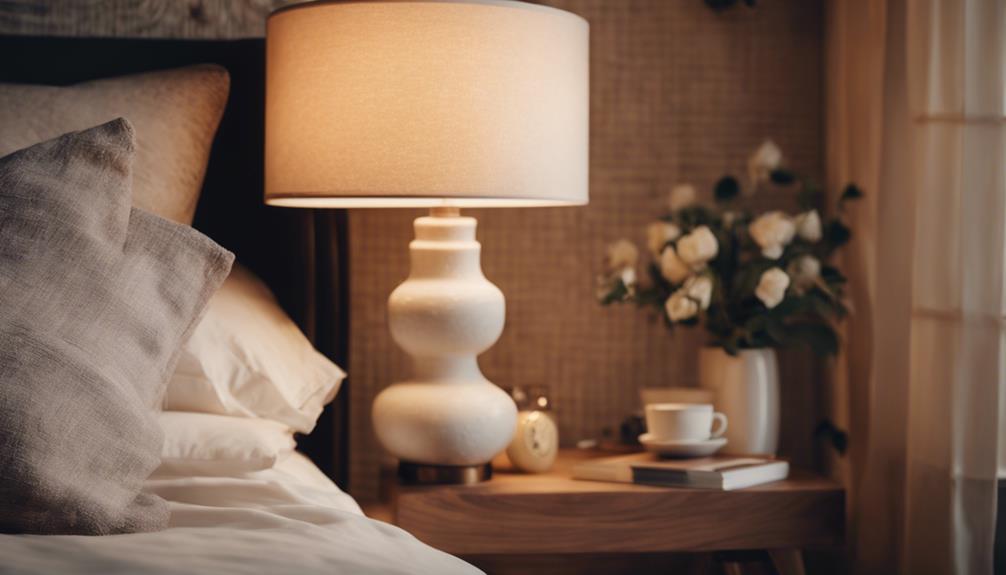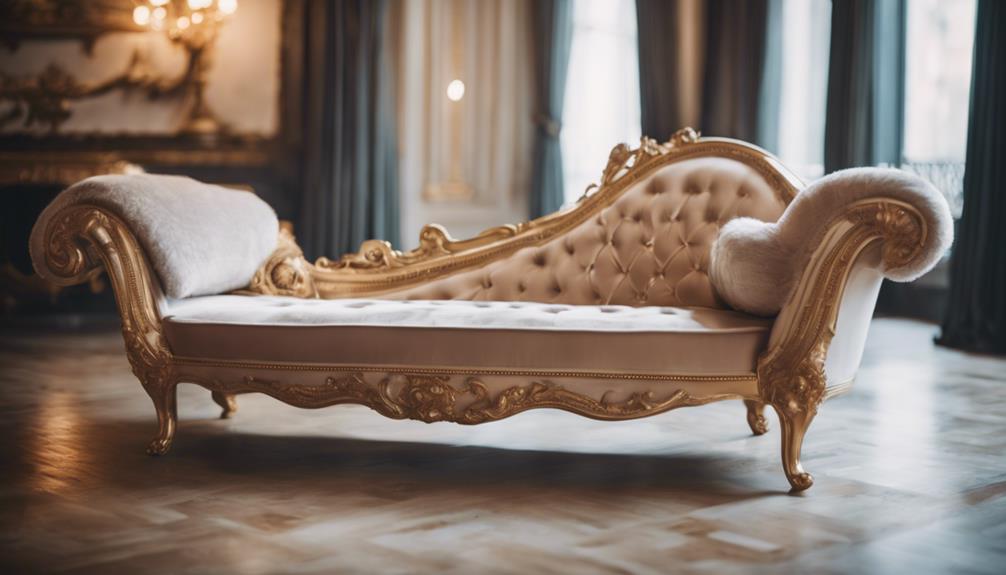Aesthetic bedside lamps are perfect for creating a cozy atmosphere and showcasing your style. With unique designs, warm color schemes, and dimmable settings, they enhance your room's decor while providing functional lighting. Whether you prefer vintage glass, modern geometric shapes, or funky jellyfish designs, there's a lamp that will impress everyone. Plus, combining these lamps with textured rugs and decorative elements, like macramé wall hangings, pulls the look together. These lamps not only brighten your space but also spark conversation. Stick around to discover how to choose the perfect lamp for your cozy retreat!
Key Elements
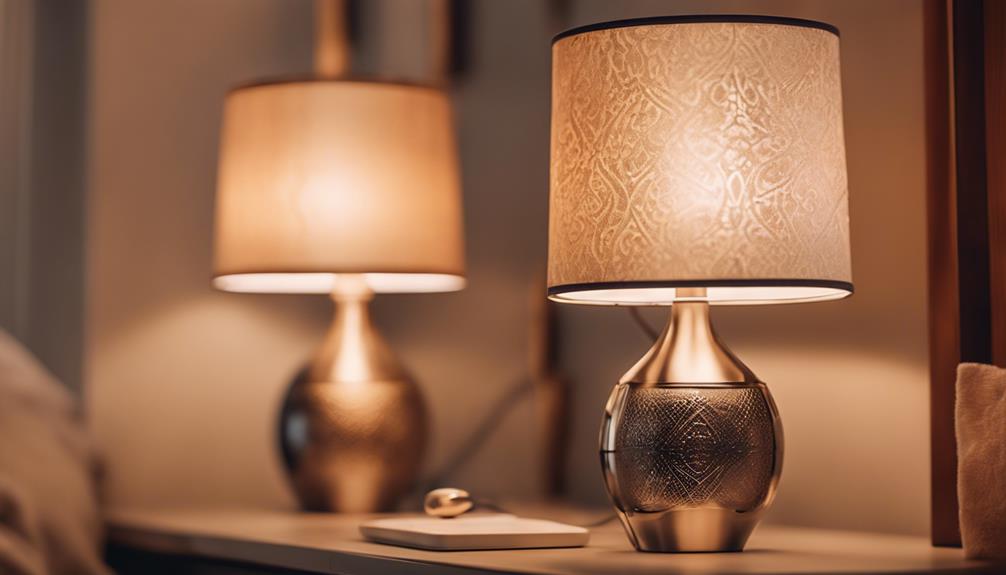
When choosing an aesthetic bedside lamp, consider the color scheme, materials, and textures that resonate with your style.
These key elements play an essential role in how the lamp enhances your space.
Color Scheme
Aesthetic bedside lamps offer a palette of colors like gray, blue, pink, and green, allowing you to effortlessly coordinate them with your room's decor. The right color scheme can enhance the overall look of your space, making it feel harmonious and inviting.
You'll find unique designs that blend different colors, such as the colorful Jellyfish Decorative Light or the vibrant Mosaic Lamp, which provide a pop of color and personality to your bedroom.
To create a cozy atmosphere, opt for lamps with warm color temperatures around 2700 Kelvin. This soft glow not only adds to the aesthetic appeal but also helps you unwind after a long day.
Dimmable options are another fantastic feature, giving you control over the brightness to match your mood and the color scheme of your room.
Whether you're going for a minimalist vibe or a more eclectic look, choosing the right lamp with the perfect color can make a significant difference. With such a variety of styles and colors available, you're sure to find an aesthetic bedside lamp that suits your taste and elevates your space.
Materials
The choice of materials in bedside lamps plays a significant role in defining their style and functionality. Aesthetic bedside lamps often feature frosted glass shades and resin lamp bodies, providing both elegance and stability. You'll find that many lamps incorporate textured fabric or ceramic materials, adding a decorative touch that enhances the cozy ambiance of your room.
When you select high-quality bedside lamps, look for those utilizing energy-efficient LED bulbs. They offer soft, warm lighting while being eco-friendly and reducing electricity consumption. The materials you choose also impact the lamp's practicality; some designs include USB ports for convenient charging, combining style with functionality.
Unique materials, like crackled glass or patterned shades, create visual interest and elevate the overall aesthetic appeal of your bedside lamp. These standout pieces not only illuminate your space but also serve as focal points in your decor.
Textures
Textures in bedside lamps greatly influence the overall vibe of your space, adding warmth and inviting charm through various materials and design elements. When you choose lamps with textured fabric shades, you create a soft, inviting glow that enhances your room's aesthetic. Options like milky white frosted glass shades or vintage pleated designs contribute to a cozy atmosphere, making the space feel more welcoming.
Incorporating materials such as resin, ceramic, and wood not only improves the tactile experience but also serves as decorative elements that complement your interior style. You can opt for lamps featuring patterned glass or mosaic designs to add visual interest and depth, appealing to your unique taste.
Moreover, many of these chic bedside lamps come equipped with energy-efficient LED bulbs that emit warm lighting around 2700 Kelvin. This gentle, eye-friendly illumination enhances the cozy ambiance, making it perfect for winding down at night.
Don't forget the importance of sturdy materials and non-slip bases; they guarantee stability while maintaining an aesthetically pleasing appearance. With the right textures, your bedside lamp can become a stunning focal point in your room.
Essential Fixtures and Furniture

When it comes to choosing essential fixtures and furniture for your bedside, the right lamp can make all the difference.
A ceramic lamp with a textured finish, a vintage-inspired glass table lamp, or a geometric metal table lamp can each add a unique touch to your space.
Let's explore how these options can enhance both style and functionality in your bedroom.
Ceramic Lamp With Textured Finish
A ceramic lamp with a textured finish instantly elevates your home decor, adding elegance and visual interest to any space. These lamps come in various colors and styles, often showcasing organic shapes and intricate patterns that catch the eye. Whether you place one in your living room, bedroom, or study area, it serves as both a functional light source and a stunning decorative piece.
One of the best features of a textured ceramic lamp is its energy-efficient design. Many models utilize LED bulbs, providing warm lighting while minimizing electricity consumption. This means you can enjoy a cozy ambiance without worrying about high energy bills.
Prices for these lamps vary, ranging from $12.99 to $228, so you can find an option that fits your budget and aesthetic preferences. The unique designs available guarantee that you can select a lamp that complements your existing decor while adding a touch of sophistication.
Incorporating a ceramic lamp with a textured finish into your home not only brightens your space but also enhances its overall charm and character. You'll impress everyone who walks through your door!
Vintage-Inspired Glass Table Lamp
Elevate your decor with a Vintage-Inspired Glass Table Lamp, which features vibrant colors and unique glass variations that make it an enchanting addition to any room. This lamp isn't just a light source; it's a statement piece that enhances the overall aesthetic appeal of your space. Available in eight stunning colors, it allows you to choose the perfect match for your decor.
As a bedside fixture, this glass table lamp provides cozy lighting that creates a warm and inviting atmosphere for relaxation or reading. You'll appreciate its combination of functionality and style—perfect for both decorative and practical use. Priced at $89, it's an affordable luxury that won't break the bank.
When you add this lamp to your room, you'll notice how it transforms the ambiance, making it feel more sophisticated and curated. With a best-selling rank reflecting its popularity, this vintage-inspired lighting solution is a must-have for anyone looking to enhance their home's charm.
Geometric Metal Table Lamp
The Geometric Metal Table Lamp brings a sleek, modern touch to your bedroom decor with its angular shapes and metallic finishes. This lamp is perfect for enhancing the aesthetics of a contemporary bedroom, creating a chic focal point on your nightstand. Available in various colors like gold and black, it seamlessly complements a wide range of decor styles.
One of the standout features is its compact size, typically around 14-20 inches in height. This makes it an ideal choice for small tables, ensuring it doesn't overwhelm your space—perfect for apartments or cozy bedrooms.
With many models using energy-efficient LED bulbs, you can enjoy stylish illumination while promoting sustainability in your home.
The sturdy base and durable metal structure guarantee stability and longevity, even in high-traffic areas like your bedroom or living room.
You'll appreciate how the geometric design elevates your lighting game, offering both practicality and aesthetic appeal. Whether you're reading in bed or setting the mood for a cozy evening, the geometric metal table lamp is an essential fixture that combines form and function beautifully.
Lighting Ideas
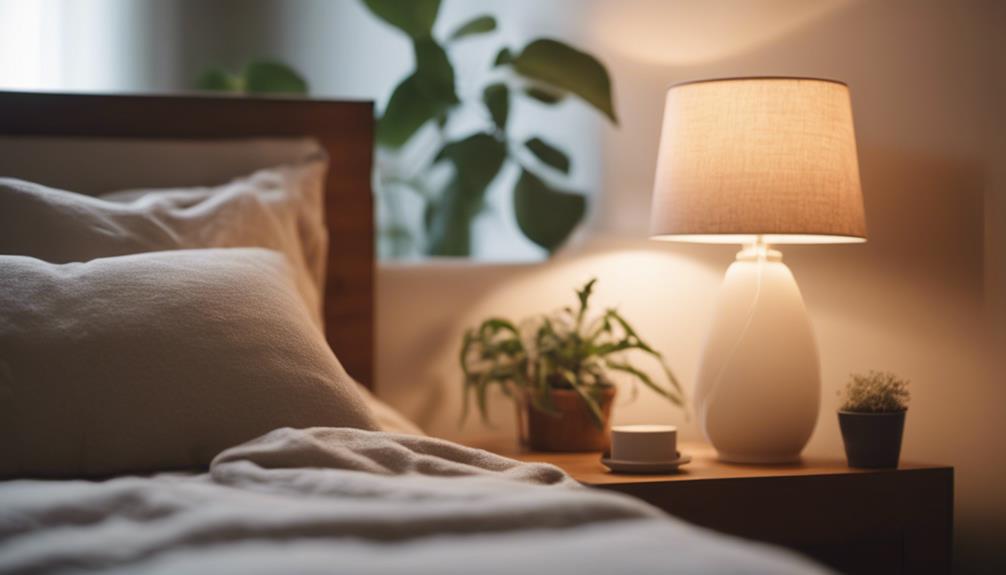
When it comes to lighting ideas for your bedside, think about how layered ambient and task lighting can transform your space.
Consider incorporating mood-enhancing dimmable pendant lights or an artistic wall-mounted fixture for a unique touch.
You might even want to explore sculptural bedside lamp designs that not only illuminate but also serve as stunning decor.
Layered Ambient and Task Lighting
Layered ambient and task lighting often transforms your bedside area into a cozy retreat, perfect for relaxation and reading.
By strategically placing bedside lamps and additional light sources, you can create a warm, inviting atmosphere that fits your needs. Aim for soft, warm light with bedside lamps around 450 lumens or lower to enhance comfort while you unwind or enjoy a good book.
Incorporating multiple light sources, like a main bedside lamp paired with smaller accent lights, adds depth and visual interest to your space.
Dimmable bedside lamps are particularly versatile, allowing you to adjust brightness levels based on your activities—whether you're reading, watching TV, or winding down for the night.
Consider unique and decorative designs that not only function as light sources but also serve as aesthetic focal points in your room.
Smart bedside lamps with adjustable colors and brightness levels further enhance your lighting experience, giving you the power to customize your cozy atmosphere according to your preferences.
With the right layered ambient and task lighting, you'll impress everyone who steps into your beautifully lit sanctuary.
Mood-Enhancing Dimmable Pendant Lights
Mood-enhancing dimmable pendant lights can instantly elevate your space, allowing you to create the perfect ambiance for any occasion. Whether you're reading a book, hosting friends, or unwinding after a long day, these lights let you adjust brightness levels to suit your mood. With options for customizable color settings, you can easily switch between warm tones for relaxation and brighter hues for focused activities.
Incorporating dimmable pendant lights into your room not only enhances the ambiance but also adds an artistic touch with unique designs like sculptural styles or organic shapes. These fixtures can serve as both functional lighting and beautiful decor elements that impress anyone who enters your space.
When choosing your dimmable pendant lights, consider using energy-efficient LED bulbs. They provide long-lasting illumination while helping you reduce energy consumption. Plus, many modern pendant lights come with smart features, making it easy to integrate them into your home automation system for voice control and programmable settings.
With the right pendant lights, you'll transform your room into a cozy haven that reflects your personal style.
Artistic Wall-Mounted Light Fixture
Exploring artistic wall-mounted light fixtures offers a fantastic way to enhance your space while saving valuable surface area, perfect for both style and functionality. These fixtures come in various designs, from vintage to modern, allowing for unique aesthetic contributions that can elevate your room decor.
One of the biggest advantages of wall-mounted lights is their space-saving nature, making them ideal for smaller rooms where every inch counts. You can free up your nightstands or tables while still enjoying effective lighting solutions. Many artistic wall-mounted light fixtures also feature customizable brightness settings, giving you the flexibility to create the perfect ambiance—whether you're winding down with a book or hosting friends.
Versatile installation options further enhance their appeal; you can choose between plug-in or hardwired setups to fit your preferences and room configuration. Pieces like the Lichen NYC Sconce and the Lostine Ava Wall Sconce seamlessly blend art and practicality, making them standout features in any space.
Sculptural Bedside Lamp Design
Sculptural bedside lamps transform your space by blending artistic flair with functional lighting, making them essential elements in modern decor. These lamps serve more than just a practical purpose; they're stunning pieces that elevate your room's aesthetic. For instance, the Noguchi Akari 1N Table Lamp and the Wooj Wavy Lamp both embody artistic design while providing effective lighting, creating a soothing atmosphere perfect for late-night reading or relaxation.
When you choose sculptural bedside lamps, you'll find a variety of unique materials and shapes that add character to your space. The Anthropologie Small Mesa Ceramic Lamp features an organic ceramic body, bringing elegance to any bedside setup. Plus, many of the best sculptural lamps, like the Jonas Wagell JWDA Table Lamp, come with customizable features, including smooth dimming options and multiple finishes. This versatility guarantees that your lamp can seamlessly fit into your existing decor style.
Incorporating these lamps not only brightens your room but also sparks conversations, reflecting current trends in artistic lighting. So, go ahead and select a sculptural bedside lamp that speaks to your personality and enhances your home's charm.
Decorative Elements
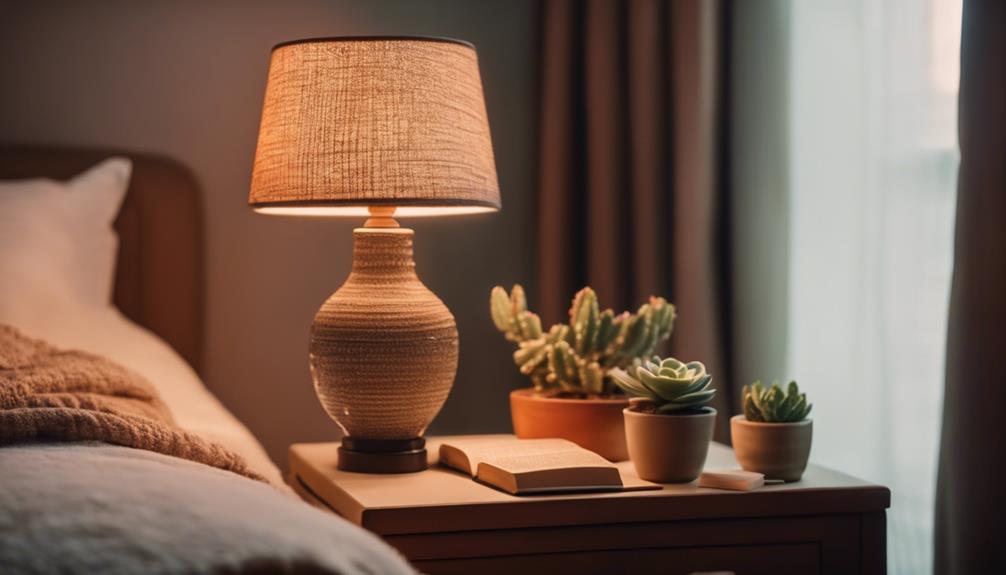
When you think about enhancing your space, consider adding decorative elements like a Bohemian macramé wall hanging or a vintage floral throw pillow.
These pieces can complement your aesthetic bedside lamp beautifully, creating a cohesive look.
A whimsical fairy light garland can also add a magical touch, elevating your room's ambiance even further.
Bohemian Macramé Wall Hanging
Bohemian macramé wall hangings bring a cozy, textured element to your space, enhancing the overall aesthetic alongside your bedside lamps. Made from natural fibers like cotton or jute, these decorative pieces add warmth and charm to any room's decor. Their intricate knots and patterns often draw inspiration from nature, perfectly complementing a bohemian style while also harmonizing with various interior designs, from minimalist to eclectic.
You can choose larger macramé hangings as statement art that commands attention, or opt for smaller pieces that subtly enrich your space. No matter the size, incorporating a macramé wall hanging creates visual interest and elevates the ambiance of your room. The texture of the macramé not only softens the atmosphere but also invites a sense of calm and relaxation.
Pairing these decorative elements with your aesthetic bedside lamps will create a cohesive look, transforming your room into a cozy retreat.
Vintage Floral Throw Pillow
Vintage floral throw pillows effortlessly elevate your decor, combining elegance with a touch of nostalgia that complements any style. These pillows are perfect for enhancing a cozy atmosphere in your room, whether you're aiming for a classic, bohemian, or modern look.
With a variety of colors and intricate patterns, vintage floral throw pillows serve as striking decorative elements that can transform your bedding or seating arrangements. When you incorporate these pillows into your space, you not only add comfort but also create an inviting environment that encourages relaxation.
The high-quality materials used in many of these pillows guarantee they're durable, making them a smart investment for your decor. They can beautifully contrast with contemporary furnishings, allowing you to blend different decor styles seamlessly.
Additionally, vintage floral throw pillows provide an excellent way to express your personality and style preferences. By choosing pillows that resonate with you, you can make a subtle yet impactful statement in your space.
Whimsical Fairy Light Garland
Incorporating whimsical fairy light garlands into your decor can add a magical glow that enhances the cozy atmosphere created by vintage floral throw pillows. These enchanting lights serve as both functional and decorative elements, making them a must-have for anyone looking to elevate their space.
You'll find fairy lights available in various styles, including battery-powered and USB-powered options, allowing for versatile placement without the hassle of electrical outlets.
What's great is that these garlands come in multiple colors and designs, so you can easily customize them to fit different aesthetic themes, from charming kawaii to edgy grunge.
Imagine draping them over your headboard or hanging them along walls to create an inviting ambiance. Many fairy lights even feature dimmable settings, so you can adjust the brightness to suit your mood, whether you're winding down for the night or hosting friends.
Flooring
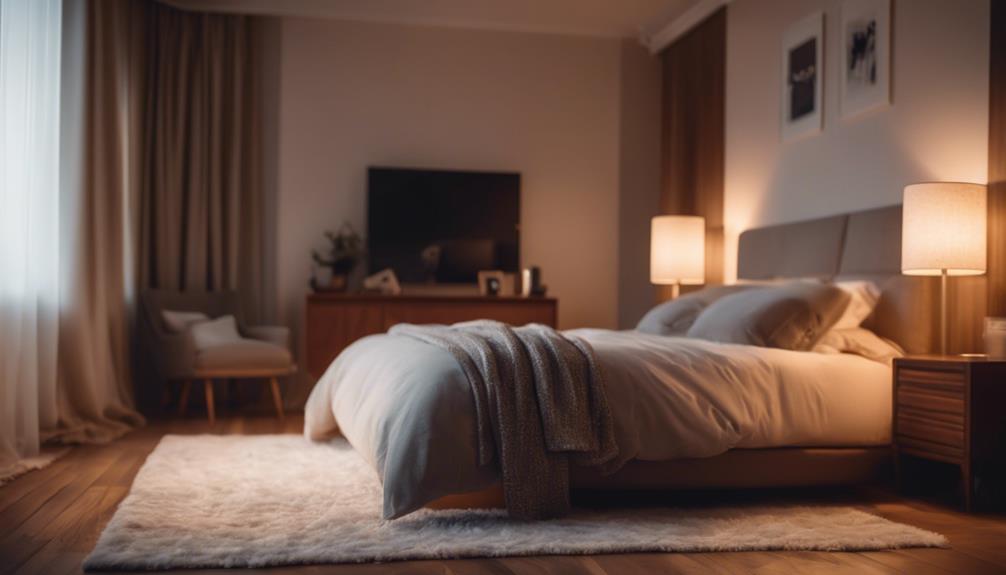
When choosing flooring for your bedroom, consider how different textures and materials can enhance the overall vibe.
A soft, plush shag carpet adds warmth, while a textured area rug in neutral tones can complement your aesthetic bedside lamps beautifully.
Alternatively, a natural jute floor mat brings an earthy touch that ties the room together while remaining stylish.
Textured Area Rug in Neutral Tones
Textured area rugs in neutral tones consistently enhance a room's aesthetic, creating a cozy and inviting atmosphere that complements any decor style. These versatile rugs can seamlessly blend with your existing furnishings, whether your space leans contemporary or traditional. By incorporating a textured area rug, you not only elevate the look of your room but also add depth and visual interest.
One of the standout features of these rugs is their ability to define areas within open-concept layouts, fostering a sense of warmth and comfort underfoot. They invite you to relax and enjoy your space. Plus, neutral tones are practical; they hide stains and wear better than darker or more vibrant colors, making them ideal for high-traffic areas.
When selecting a textured area rug, consider materials like wool, cotton, or synthetic fibers, as each offers a unique feel and appearance. This choice will further enhance the cozy atmosphere of your room.
Soft, Plush Shag Carpet
Adding soft, plush shag carpets to your space can elevate the cozy atmosphere created by textured area rugs, providing an inviting feel underfoot. These carpets are renowned for their luxurious texture and comfort, making them a perfect choice for bedrooms and living areas. With pile heights ranging from 1 to 2 inches, they enhance your room's plush appearance, inviting you to sink your feet into their softness.
You'll find shag carpets in a diverse array of materials, including polyester, nylon, and wool, allowing you to select options that suit your durability and maintenance preferences. Plus, the wide range of colors and patterns means you can easily find a style that complements your aesthetic, whether it's modern or bohemian.
To keep your shag carpet looking fresh and cozy, regular maintenance is key. Vacuuming regularly and scheduling occasional professional cleanings will prolong its lifespan, ensuring it remains inviting for years to come.
Natural Jute Floor Mat
Natural jute floor mats bring an eco-friendly and rustic charm to your space while offering durability and strength for high-traffic areas. Made from biodegradable fibers, these mats are a sustainable choice that can elevate your interior design.
Whether you prefer a bohemian look or a minimalist vibe, jute floor mats are available in various sizes, patterns, and textures to fit your style perfectly.
One of the standout features of jute mats is their durability; they withstand daily wear and tear, making them ideal for entryways or family rooms. Plus, they provide excellent insulation, helping to keep your space warm in the winter and cool during the summer months.
Maintaining your jute floor mat is a breeze; they're easy to clean and require minimal effort to keep them looking fresh. Regular vacuuming will remove dirt, while spot cleaning with mild soap and water can tackle any stubborn stains.
Conclusion
Incorporating aesthetic bedside lamps into your room can transform your space into a cozy retreat that impresses everyone.
By choosing the right fixtures and complementing them with thoughtful decor and flooring, you'll create an inviting atmosphere.
Don't underestimate the power of lighting—it's the finishing touch that ties your whole room together.
So go ahead, choose the perfect lamp, and watch your space come alive with warmth and style!
